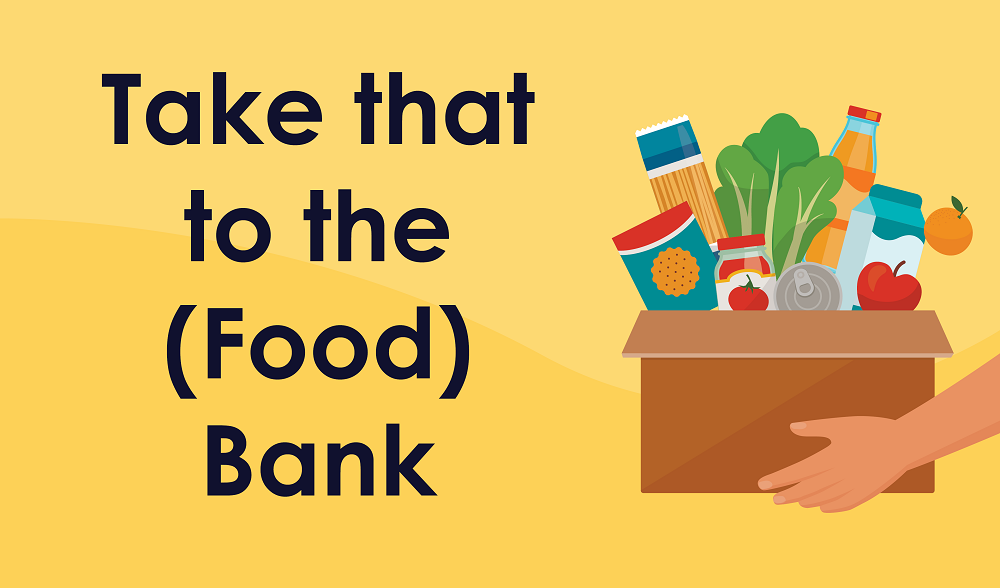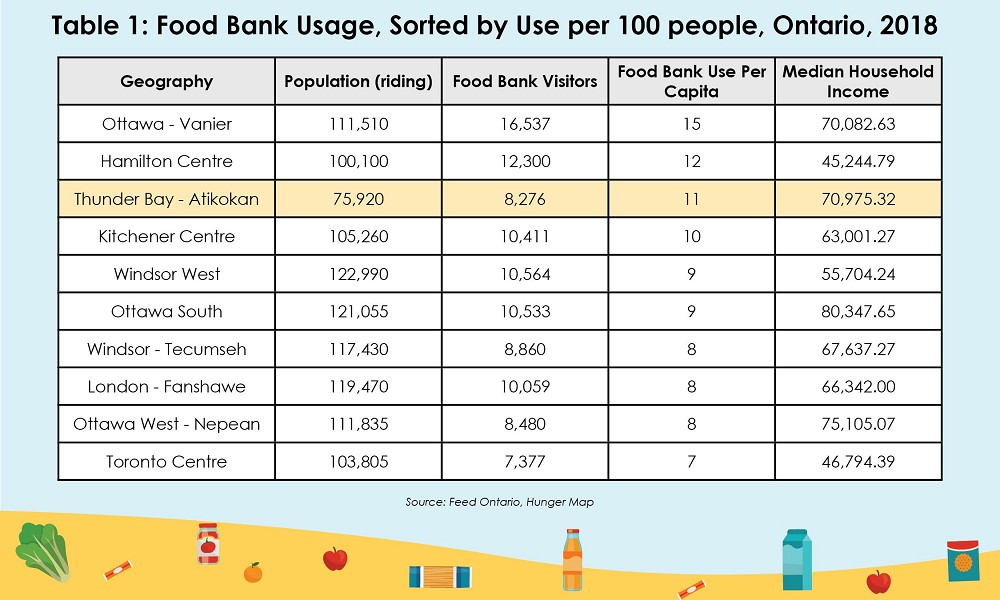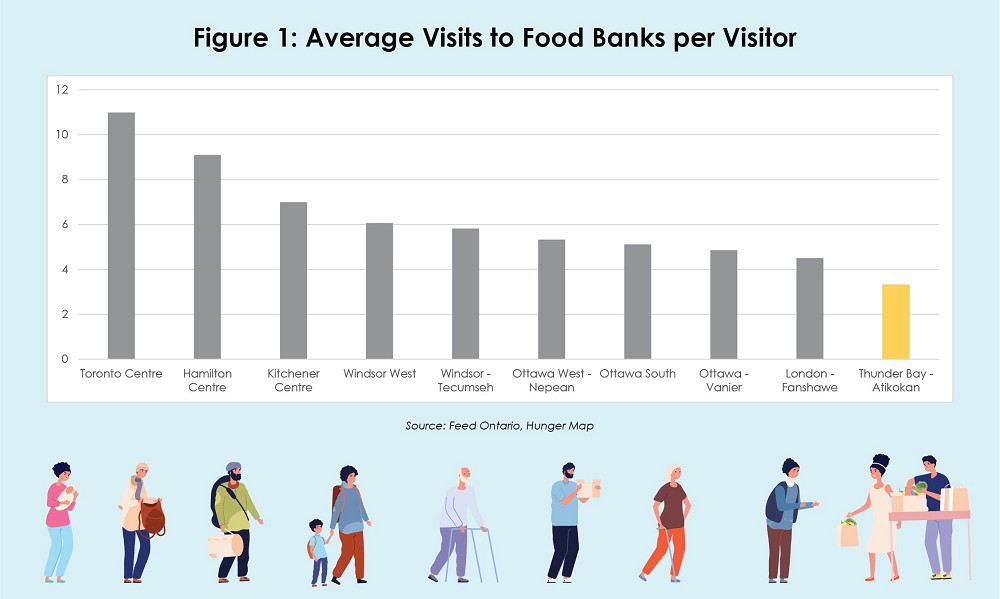Take that to the (Food) Bank
January 11, 2021 - This blog first appeared in The Walleye Magazine, January issue.

Food banks can be a valuable lifeline in a normal year, and can only become more so in the current pandemic-recession we currently find ourselves in. After most Thunder Bay food banks closed earlier in the year, local organizations have had to step up to meet the growing demand.
A centralized food bank operating out of the CLE grounds earlier in the pandemic was certainly not ideal, with many having to bus across the city and deal with queues in the hundreds. Other organizations have done their best to fill the gaps. Take, for example, the Dew Drop Inn, which served more meals by the end of October than it had in all of 2019. In the current situation, such efforts are needed across the province, and indeed, across the country.
Feed Ontario, formerly the Ontario Association of Food Banks, is a provincial network of more than 1,200 food banks and hunger-relief agencies. The organization researches long-term solutions to poverty, while its member agencies secure and distribute over 5 million pounds of fresh food, and non-perishables annually.
Food bank usage had already been increasing before the pandemic. Feed Ontario reported that from April 1st 2018 to March 31st 2019, over 500,000 individuals accessed food banks, making 3,059,000 total visits. The next year saw visits rise to 3.28 million visits. It is perhaps unsurprising to know that the primary reason for visits was individuals and families not having sufficient income to afford all basic necessities each month.
Feed Ontario publishes annual reports and has an interactive food bank usage map on their website. The data in Table 1 below was pulled from this map. The table shows food bank usage, median household income, total visitors and population for each geography area.

According to Table 1, in 2018, Thunder Bay - Atikokan had the third-highest rate of food bank usage in the province, behind only Ottawa - Vanier and Hamilton Centre. Another interesting observation is that we typically would expect that places with low median household incomes would have a higher share of the population living near the poverty line, which translates into higher food bank usage. While this is true for Hamilton Centre, the table shows that Thunder Bay - Atikokan does not follow that logic. We see that our area has the third-highest median household income compared to the other areas.
A standard metric for measuring poverty is the share of the population earning half of the median income. Based on this, half of the median income for Hamilton Centre would be $22,622 and for Thunder Bay - Atikokan it would be $35,487. Overall, based on this information, we can conclude that either:
- A) Thunder Bay’s population accessing food banks are either relatively better-off than those in Hamilton Centre, or
- B) Thunder Bay - Atikokan’s food bank patrons are in similar situations as individuals in Hamilton Centre and are farther below the local poverty line.
Either way, it is apparent that the Thunder Bay - Atikokan has a high number of individuals accessing food banks, although other regions see more visits per food bank - goer.

Of course, 2020 was a unique year, with the ongoing COVID-19 pandemic causing sharp employment losses in March and April that have been slow to recover from. It should thus come as no surprise that food banks saw a surge in demand at the onset of the pandemic, and are reporting that half of visitors surveyed worry of being evicted.
Those at the bottom of the earnings distribution have seen the highest rates of layoffs, with industries that employ the highest shares of minimum wage workers – food service and accommodation, and retail – shedding the most jobs. These are the people that generally access food banks in normal years, meaning even further reliance despite government efforts to keep the economy afloat.
With 2020 in the rear-view mirror, it seems unlikely that things could get any worse. However, the arrival of a COVID-19 vaccine should mark the turning point in the fight against the virus. One can only hope that a strong economic recovery can begin to reverse the damage of the pandemic and get back on track in the uphill battle against poverty.
Write for us
Raven Wheesk is an Economist at NPI.
The content of Northern Policy Institute’s blog is for general information and use. The views expressed in this blog are those of the author and do not necessarily reflect the opinions of Northern Policy Institute, its Board of Directors or its supporters. The authors take full responsibility for the accuracy and completeness of their respective blog posts. Northern Policy Institute will not be liable for any errors or omissions in this information, nor will Northern Policy Institute be liable for any detriment caused from the display or use of this information. Any links to other websites do not imply endorsement, nor is Northern Policy Institute responsible for the content of the linked websites.
Northern Policy Institute welcomes your feedback and comments. Please keep comments to under 500 words. Any submission that uses profane, derogatory, hateful, or threatening language will not be posted. Please keep your comments on topic and relevant to the subject matter presented in the blog. If you are presenting a rebuttal or counter-argument, please provide your evidence and sources. Northern Policy Institute reserves the right to deny any comments or feedback submitted to www.northernpolicy.ca that do not adhere to these guidelines.
